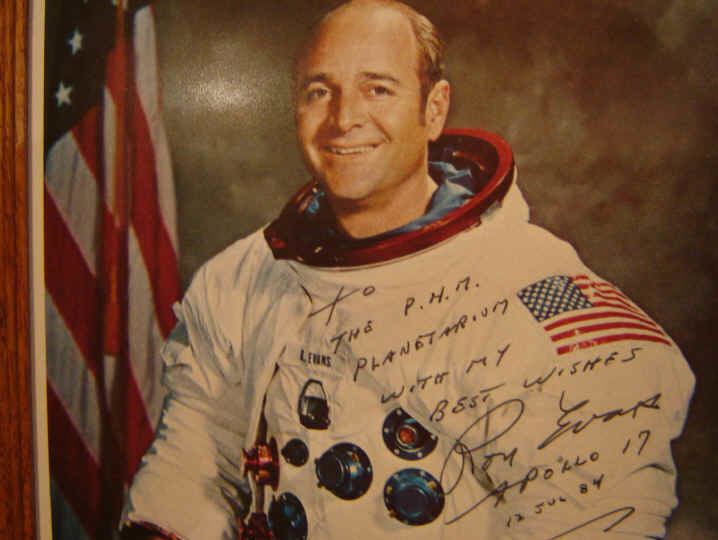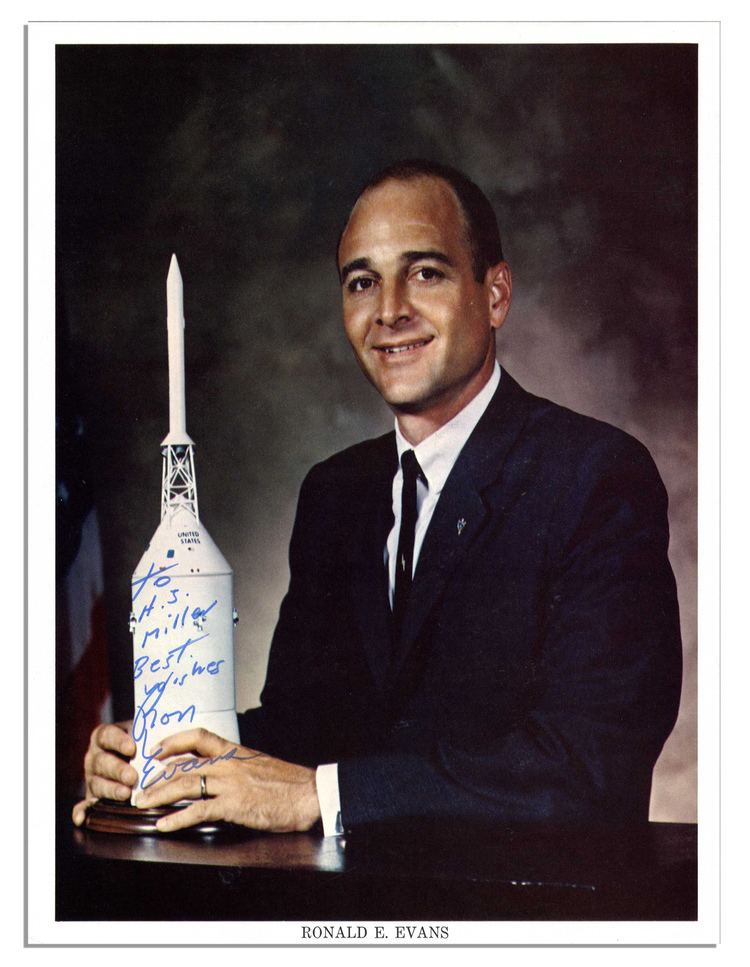Nationality American Role Engineer Status Deceased | Time in space 12d 13h 52m Name Ronald Evans Space agency NASA | |
 | ||
Born November 10, 1933St. Francis, Kansas, U.S. ( 1933-11-10 ) Other names Ronald Ellwin Evans, Jr. Alma mater KU, B.S. 1956NPS, M.S. 1964 Rank Captain, United States Navy | ||
Ronald Ellwin "Ron" Evans Jr. (November 10, 1933 – April 7, 1990), (Capt, USN), was an American naval officer and aviator, electrical engineer, aeronautical engineer, and NASA astronaut, also one of only 24 people to have flown to the Moon.
Contents
- Early life and education
- Military service
- NASA career
- Later years
- Awards and honors
- Physical description
- References

Evans was selected as an astronaut by NASA as part of Astronaut Group 5 in 1966 and made his first and only flight into space as Command Module Pilot aboard Apollo 17 in 1972, the last manned mission to the Moon to date, with Commander Eugene Cernan and Lunar Module Pilot Harrison Schmitt. During the flight, he orbited the Moon as his two crewmates descended to the surface. Consequently, he is the last person to orbit the Moon alone and holds the record for the longest lunar orbit by a human at 148 hours. In 1975 Evans served as backup Command Module Pilot for the Apollo-Soyuz Test Project mission.

Early life and education

Evans was born on November 10, 1933, in St. Francis, Kansas, to parents Clarence Ellwin Evans (1911–1985) and Marie A. Evans (née Priebe; 1913–1992). He had two siblings, Larry Joe Evans (1935–1951) and Jay Evans. He was active in the Boy Scouts of America where he achieved its second highest rank, Life Scout. He graduated from Highland Park High School in Topeka, Kansas in 1951, received a Bachelor of Science degree in Electrical Engineering from the University of Kansas in 1956, and a Master of Science degree in Aeronautical Engineering from the U.S. Naval Postgraduate School in 1964. He was a member of Tau Beta Pi, Society of Sigma Xi, and Sigma Nu.
Military service

In June 1957 he completed flight training after receiving his commission as an Ensign through the Navy ROTC Program at the University of Kansas. Upon receiving aviator wings until 1962, he was a fighter pilot with Fighter Squadron 142 (VF-142), serving on two aircraft carrier cruises in the Pacific Ocean, then a combat flight instructor for the F-8 aircraft with Fighter Squadron 124 (VF-124).

From 1964 to 1966 Evans was on sea duty in the Pacific, assigned to Fighter Squadron (VF-51), flying F-8 Crusader from the carrier USS Ticonderoga. During this assignment, he completed a seven-month tour of duty flying combat missions in Vietnam War. He was with VF-51 when he was selected as an astronaut in April 1966.
Evans logged 5,500 hours of flight time, including 5,000 hours in jet aircraft.
NASA career
Evans was one of the 19 astronauts selected by NASA in April 1966. He served as a member of the astronaut support crews for the Apollo 7 and Apollo 11 flights, and as backup Command Module Pilot for Apollo 14.
Evans' first and only space flight was as Command Module Pilot of Apollo 17, the last scheduled U.S. manned mission to the Moon. He was accompanied by Eugene Cernan and Harrison Schmitt. While Cernan and Schmitt landed and worked on the Moon in the Taurus–Littrow valley, Evans remained in lunar orbit on board the Command Module America, completing assigned work tasks which required visual geological observations, hand-held photography of specific targets, and the control of cameras and other highly sophisticated scientific equipment carried in the service module's SIM bay.
On the way back to Earth, Evans completed a one-hour, six-minute extravehicular activity, successfully retrieving three camera cassettes and completing a personal inspection of the equipment bay area. He logged 301 hours and 51 minutes in space, 1 hour and 6 minutes of which were spent in extravehicular activity. He holds the record of most time spent in lunar orbit: six days and four hours (148 hours).
Evans was later backup Command Module Pilot for the Apollo-Soyuz Test Project (ASTP) mission.
Evans retired from the U.S. Navy as Captain on April 30, 1976, with 21 years of service, and remained active as a NASA astronaut involved in the development of NASA's Space Shuttle program. He served as a member of the operations and training group within the Astronaut Office, responsible for launch and ascent phases of the Space Shuttle flight program.
Later years
Evans retired from NASA in March 1977 to pursue a career in the coal industry. Later he worked with Western American Energy Corporation in Scottsdale, Arizona and was Director of Space Systems Marketing for Sperry Flight Systems.
He died in his sleep of a heart attack in Scottsdale, Arizona, on April 7, 1990, and was survived by his widow Jan; his daughter, Jaime D. Evans (born August 21, 1959); and his son, Jon P. Evans (born October 9, 1961).
Awards and honors
Evans was presented with the NASA Distinguished Service Medal in 1973, the Johnson Space Center Superior Achievement Award in 1970, the Navy Distinguished Service Medal in 1973, Navy Astronaut Wings, eight Air Medals, the Vietnam Service Medal, and the Navy Commendation Medal with combat distinguishing service in 1966. He received a University of Kansas Distinguished Service Citation in 1973, and was named Kansan of the Year in 1972. He was inducted into the International Space Hall of Fame in 1983, and the U.S. Astronaut Hall of Fame on October 4, 1997.
